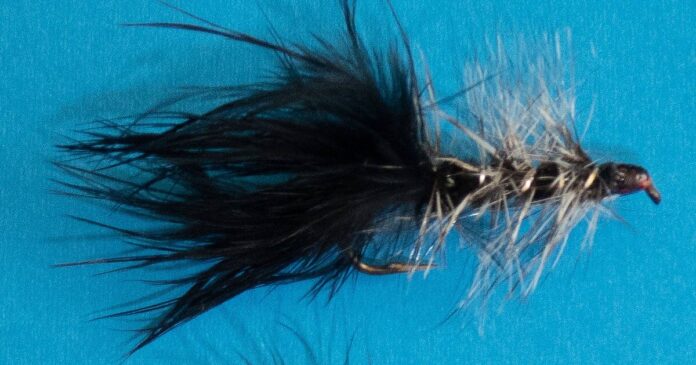The wooly bugger is arguably the best-known fly pattern in the world, often the first fly a beginning fly fisherman ties and fishes.
It is easy to tie, easy to fish and remarkably effective for a large number of species including trout, panfish, bass and carp. This is one of those “something or other that seems alive” attractor patterns, but it can imitate large nymphs, baitfish, drowning terrestrials, insects, crayfish, shrimp, crabs, clamworms, leeches and who knows what else.
The fly’s precise origin is unknown, but it’s widely attributed to Pennsylvanian Russell Blessing in 1967, basically adding a marabou tail to a Wooly Worm, a pattern that goes back centuries.
The classic pattern calls for a 2X or 3X long streamer hook, a marabou tail the length of the hook shank, a chenille body Palmer-hackled with a saddle hackle feather. Then the hackle is reinforced by an extra piece of tying thread: mono or a thin gold, silver or copper wire. All but the wires are black.
There are dozens and dozens of internet sites and books detailing how to tie the fly. With the classic pattern, the sequence is to first add weight if desired, then tie in the tail, then in the same area, tie in the tip of the chenille, then the tip of the hackle feather, then the end of the wire. Then wind each forward in the order added, with the wire or other reinforcer counter wound in the opposite direction of the hackling spiral, teasing it in place so that it does not trap hackle fibers.
Weight: Weight can be added at the eye of the hook with a beadhead, cone or even dumbbell eyes. In my opinion, bright weights can be a turn-off for pressured fish in clear water like the Gunpowder. A black felt tip can tone down the flash. These weights can work in moving water or when imitating prey like crayfish or sculpins. In still waters, many feel no weight or small wraps of non-lead wire mid-hook shank give more lifelike swimming action.
Tail material: I recommend not adding any flash material to a marabou tail.
Body material: Standard, right-sized chenille or cactus chenille are fine. The latter can be used with or without standard hackle.
Hackle feathers: Use “wooly bugger” quality saddle hackle feathers in black, grizzly or a color matching the fly’s body, no need for expensive dry fly quality.
Hackle adds to the appeal of a fly. Hackle that is not secured with some counter wrapping will break after a few fish. One easy way to fix this with a purchased fly is to attach tying thread at the tail of the fly then counterwind as above and tie off at the head. You can also make a wooly bugger version of a marabou jig, like a crappie jig, by tying on thread at the jighead, then tying in a hackle feather, wind back the tying thread to the tail, Palmer hackle to the tail, then counter wind back the thread to the head and tie off.
Colors: All kinds of garish color combinations are used. I like black, olive chenille or cactus chenille with matching or contrasting hackle. Purple is interesting for trout. All white has worked well for me for smallmouth and trout. Grizzly (white/black) saddle hackle works well with all body colors.
Carroll County Daily Headlines
Daily
Get the day’s top news and sports headlines.
Flies that are sold often seem created more to appeal to fishermen than fish and are often tied too big and with and too much material and glitz. These creations can work on stocked trout, in stained water and for steelhead and salmon, but smaller, simpler patterns work better in most everyday situations with trout, bass and panfish.
Years ago I attended a presentation by an expert on winter fishing for trout in Maryland and Pennsylvania streams. His only fly was a small, black, basic wooly bugger.
This nondescript fly comes alive in the water and is the best crayfish imitation I’ve ever seen. I’ve taken countless Potomac River smallmouth with this fly making short casts upstream into fast water and retrieving quickly. Tie this heavily weighted in size 4 or 6 with a tan or olive chenille body, matching hackle and a matching rabbit strip tail. This fly also works in slower rivers and in ponds with crayfish —like most mid-Atlantic.
In moving waters, make a short, upstream cast and retrieve as above with weighted buggers for aggressive fish — or try “high stick nymphing.” Another approach is to cast across the current, let the fly sink and swing downstream with an occasional twitch then retrieve back trying different speeds of retrieves. A dead drift downstream is another with varying speeds and actions on retrieve.
Still waters can be fished by slowly bottom bouncing with heavily weighted flies or swum with lifts and pauses for lightly weighted buggers, especially with those center weighted.
Some of the above weighed flies and jigs can be fished with ultralight tackle with 4-pound test mono. A casting bubble above a bugger allows fishing with conventional spinning tackle.
When pond fishing in pickerel waters, I use a 20-pound bite leader. We often come across shoreline downed trees loaded with panfish. Adding a duolock clip allows me to attach a size 10 black wooly bugger below a casting bubble to take bluegill/sunfish and crappie and occasionally bass and pickerel. I have had successful days with bass and panfish in reservoirs with this “float and fly” rig.
Credit: Source link































